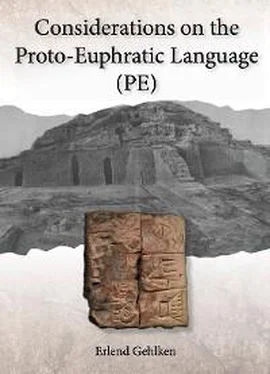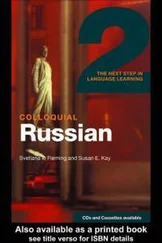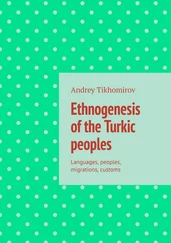Considerations on the Proto-Euphratic Language
1. Auflage, erschienen 4-2021
Umschlaggestaltung: Romeon Verlag
Text: Erlend Gehlken
Layout: Erlend Gehlken
ISBN: 978-3-96229-818-0
www.romeon-verlag.de
Copyright © Romeon Verlag, Jüchen (DE)
The work, including all its parts, is protected by copyright. Any use and reproduction of the work without the consent of the publisher is prohibited and punishable by law. All rights, including those of reprinting excerpts and translation, are reserved. The work, including parts thereof, may not be reproduced, transmitted or copied without the express written permission of the publisher. Violation obliges to compensation.
All information, results, etc. contained in the book have been prepared by the author to the best of his knowledge. They are provided without any obligation or guarantee on the part of the publisher. He therefore accepts no responsibility or liability for any inaccuracies that may exist.
Considerations on the Proto-Euphratic Language (PE)
A Daniela,
in ricordo del tempo trascorso insieme a Sanremo
Preface
I.Introduction
‘Technical’ Remarks
II.The “PE Question”
III.Writing, Vocabulary and Grammar
IV.Document Observations
Various Types of Lists, Calculations, Festival Texts, Calendars, Field Texts, BA, GI & GU 7, Additional Payment Notes
V.Detail Studies
EN, ḪAL GAR, UB ŠÀ, Homophones, BA & GU 7: c1/168 and c1/156
VI.“Non-Sumerian” Sign Combinations, Abandoned and Retained PE Signs, New Sumerian Readings
VII.Selected PE Personal Names
Bibliography
Index of Terms
Logograms
Words
1Akkadian
2Sumerian
3Proto-Euphratic (PE)
Index of Names and Subjects
Non-PE Personal Names
Gods, Nature Spirits and Stars
Countries, Towns and Rivers
Temples and Other Buildings
Subjects
Index of Texts
Abbreviations
Literature
General Abbreviations
Conventions Used in the Transcriptions and Translations
Appendix: Cuneiform Script
Figures
Notes
One of the most important advanced civilisations of antiquity is to be found in Mesopotamia, a second one in Egypt. There may have been more ancient cultures, but they have not yet emerged from the mists of history. It goes without saying that this study refers to cultures that have developed a system of writing as we know it. The artists who created the paintings in the caves of Altamira, Lascaux or in the Maros-Pangkep Karst on Sulawesi were no less talented. The indigenous inhabitants of Mesopotamia are difficult to grasp as a people. In the north of the country, rain-fed agriculture was feasible, but not in the south. Accordingly, the south of the country was settled at a late stage. Nobody knows when and from where the Sumerians migrated to Mesopotamia.
No notable Assyriologist claims that the Sumerians were the first settlers in southern Mesopotamia, but almost all Assyriologists are of the opinion that the first settlers had not yet written down their language, the “Proto-Euphratic language” (henceforth PE; an artificial word). In general, the Sumerians and the Egyptians are considered to be the ones who, according to current knowledge, created the first writing systems. For Mesopotamia, one of the most prominent advocates of this opinion was the well-known Heidelberg Assyriologist Adam Falkenstein († 1966), who in 1936 was the first to publish a volume with archaic texts from the city of Uruk, from which the oldest written documents originate. His most prominent, albeit somewhat hesitant, “opponent” was Robert K. Englund († 2020), who wrote under the keyword “The 4 thmillennium” in the article “Uruk. A. I. Philologisch. 4.–3. Jahrtausend” in the “Reallexikon der Assyriologie” (vol. 14, published in fascicles 2014–2016): “The consensus among specialists is that the number of identified probable phonetic renderings of protocuneiform signs indicates that Sumerian was at least one of the languages employed by Late Uruk scribes (and by logical extension, the only one) (among many others, cf. Nissen 1999, 45f.; Cooper 2004; Krebernik 1994a; Rubio 2005). Englund (1998, 73–81; id. 2009, § 2.5) and Whittaker (2005) remain sceptical; s.a. the discussion in Sumer*, Sumerisch. § 6.”
This short study attempts to securely and sustainably validate the existence of a written form of the PE language. Almost all the material presented here has been published before. The aim of this publication is to gather the scattered published views so as to enable a better understanding of this discussion. Robert K. Englund’s investigation Texts from the Late Uruk Period in OBO 160/1, in which he presents and analyses the archaic text corpus of the Uruk period in an exemplary manner, remains fundamental.
This book is also addressed to the interested lay person. For this reason, explanations that the specialist colleague must consider superfluous have often been given. The appendix “Cuneiform Script” has been added for orientation.
My sincere thanks go to ROMEON Verlag (Kaarst, Germany) for publishing this study. The beneficial and cooperative collaboration – especially with the Creative Director, Mr Christian Türling – as well as the pleasing presentation of the book speak for themselves. My special thanks are due to Mr Derek O’Brien (University of Heidelberg), who carefully reviewed the English translation and, with critical questions in cases of factual doubt, made a valuable contribution to the success of this work.
| Frankfurt/Main, November 2020 |
Erlend Gehlken |
It is not easy to write about something that most people believe did not exist – that is, the writing of texts in the PE language. Here, however, the attempt has been made. Honest criticism would not only help (or dismiss) the recognition of the existence of a written form of the PE language, but also promote understanding of Sumerian in the archaic texts. Philological questions will be dealt with in the following chapters; at this point the external framework will be outlined first.
1. Colonisation of Mesopotamia
After smaller predecessor settlements in the Pre-Pottery Neolithic, in the Pottery Neolithic the Hassuna culture, named after the site of the same name, developed in northern Mesopotamia in the second half of the 7 thmillennium BC in the zone where rain-fed farming was possible 1. In the regions bordering Mesopotamia there were also important centres at this early time, such as Jericho in the Levant or Chogha Mish in the Khuzistan Province (modern Iran). An example of a city outside the Fertile Crescent is Çatal Höyük, southeast of Konya (Anatolia). In Mesopotamia itself, around 6300, the Samarra culture emerged, which flourished in the south of the country contemporaneously with the Hassuna culture for quite some time before the extinction of the latter. In the area of the Samarra culture rain-fed agriculture was not possible; the first irrigation systems are to be found here. Around 6000, two other cultures came into the light of history: the Halaf culture in the north of the country and the Ubaid (Obed) culture in the south 2. The area where the Halaf culture is to be found would soon extend from Samarra in the south up the Tigris River almost to its source and from there in a westerly direction far beyond the Euphrates River towards the Mediterranean Sea. A striking feature of this culture is its aesthetically pleasing polychrome painted pottery. The southern regions of Mesopotamia were only settled relatively late. Most of the countryside was previously flooded. Only climate change and the associated drop in sea level in the Persian Gulf ensured that permanently dry stretches of land were available 3. A characteristic feature of the Ubaid culture is the unmistakable terracottas in which the human face is reminiscent of that of a lizard. The Ubaid culture spread rapidly. After a few hundred years, it covered the entire area of the Halaf culture in addition to southern Mesopotamia and also reached the Mediterranean Sea (the region of the east coast north of Ugarit).
Читать дальше












